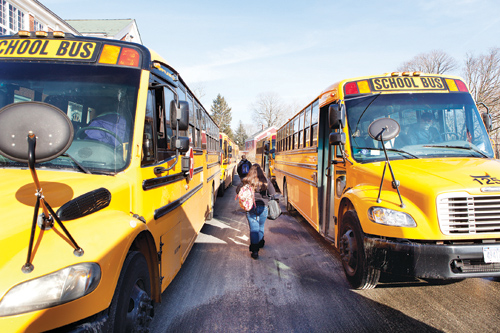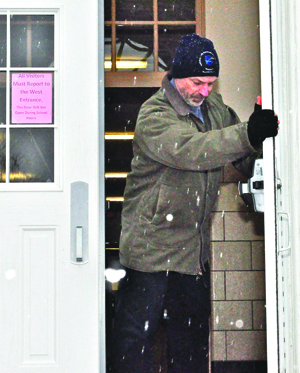Special Report: School safety after Sandy Hook

The door is locked.
You push a button, identify yourself through a video camera and you’re buzzed in. A greeter asks you to sign a book, put on a name tag and wait for an escort. In some cases, you’re asked to surrender your driver’s license. You’ll get it back when you leave.
For most people accustomed to visiting a North Fork school, this might seem like an unusual set of steps to gain entrance.
But this is the new reality.
This procedure has become the norm here since 27 people — including 20 children and the gunman — were killed Dec. 14 at Sandy Hook Elementary School in Newtown, Conn.
School districts have been enhancing their security systems and emergency plans over the past month, as they come into compliance with a new state mandate. On Jan. 15, the state gave schools seven days to post security plans on district websites. For protection, those postings don’t include certain details, such as building plans and hiding locations.
School officials aren’t the only ones gearing up to prevent potential tragedy.
During an interview with The Suffolk Times Friday, Southold Police Chief Martin Flatley said photos and maps of school grounds have been uploaded to computers in each patrol car and officers are visiting schools to become more familiar with their layouts.
“Most of the officers here have kids in school, so they are just as concerned as every other parent,” he said.
Related: 10 steps taken to secure North Fork schools
Related: Rising to the challenge
Chief Flatley said he believes it’s important for schools to narrow access points down to one entrance and monitor visitors through buzzer and camera systems. He also warned that many school shootings have involved someone who “has been associated with the school or a student themselves.”
“The illusion that it’s a guy walking up to the door with a trench coat and a machine gun underneath with a black hat on is not the case,” he said.
The districts have begun to come into compliance with the new state mandate, though some school boards have not yet met to approve their plans.
The Southold Board of Education unanimously approved its district-level security plan last Wednesday night.

During the board’s regular meeting, member Scott DeSimone questioned the state mandate and described it as “ridiculous.”
“It makes them look like they are doing their jobs by making us put something up [online],” he said.
Board president Paulette Ofrias described the district plan as a template the board received from BOCES. It was posted online last Thursday.
About a week after the Newtown shooting, the Southold board approved funding to install new locking safety doors at the elementary school.
Most school districts already have buzzer systems in place and many are adding video cameras.
New Suffolk school officials said that while there are cameras outside the tiny district’s one building on Fourth Street, another camera will be added to the exterior of the main entrance. It currently has a peephole in the door.
New Suffolk board president Tony Dill said the district also has an intercom system at the entrance and the school secretary’s desk is located in the main lobby, where she can monitor visitors.
“When we put the camera system in, we didn’t include that area because we concentrated on areas where you couldn’t see,” Mr. Dill said. “The biggest advantage we have is that there’s only two doors into the place, so that we don’t have multiple entrances and exits we have to monitor. Our problems are far, far simpler than would normally be the case with other schools and other districts.”
Greenport has allocated $3,800 to improve its security system with new video cameras and two five-inch video monitors visible to main office personnel.
In addition, the district is in the process of replacing its handheld walkie-talkie radios with either shoulder or earpiece radio sets for audio quality reasons.
Substitute teacher Frank Musto is volunteering his time to help keep Greenport students safe by monitoring each person entering the school. He’s working with school officials to develop a volunteer security program and hopes other community members donate a few hours to the cause.
Chief Flatley said he liked Mr. Musto’s idea and believes it could work because many retired police officers reside in town.
“For somebody like that to step up, I think it’s great,” the chief said.
At the Mattituck-Cutchogue School District, which has a part-time security guard in each of its two buildings, officials said they’re in the process of getting quotes to install a buzzer and camera system.
High school principal Shawn Petretti said during a Jan. 17 board meeting that some offices along the main lobby have been rearranged to improve hallway visibility.
The district is also requiring visitors to surrender their driver’s licenses. The thought is to encourage visitors to exit via the main entrance, Mr. Petretti said.
All exterior doors are locked during the school day. New signs have also been added to each door that read: “Do not open this door during school hours for anyone.”
“Schools were designed to educate kids and not be fortresses,” Mr. Petretti said. “Typically, if an adult knocks on a door and asks ‘Can you open the door for me?’ students are going to comply because that’s how they were brought up.”
The Oysterponds School in Orient installed a buzzer and camera system at its main entrance this summer and hired Jacob Bogden as a part-time security guard. Mr. Bogden is a seasonal town police officer.
During the Oysterponds school board’s Jan. 15 meeting, Superintendent Dick Malone said the position is needed to make sure visitors sign in upon entering the building.
“Although everyone knows each other, this sets a serious tone that there needs to be a tightening of who’s entering and leaving,” he said.
None of the security guards at North Fork schools is armed.
Some parents have called on school districts to hire armed security since 20-year-old Adam Lanza blasted his way into Sandy Hook Elementary School with a .223-caliber rifle and caused the second-deadliest school shooting in the nation’s history.
Chief Flatley said that although he’s heard some school board members and residents push for armed security, he doesn’t believe it’s a solution.
“I’d rather see the schools spend their time and effort on controlling access points with cameras on the outside and making sure only certain people are admitted,” he said.
The chief said he disagrees with the National Rifle Association’s call for Congress to fund armed officers in every American school, describing the measure as impractical.
“We don’t have the manpower to put an officer in every school and I don’t think the schools have the resources or the money to hire armed security guards,” he said.
Anti-gun advocates have said adding armed security isn’t the answer since an armed sheriff’s deputy was assigned to Columbine High School in Littleton, Colo., the day of the 1999 massacre there, which left 15 people dead — including 12 students, a teacher and both gunmen, who committed suicide after a rampage lasting nearly 22 minutes. Similarly, Virginia Tech’s police force was unable to stop the violence in 2007, when a gunman killed 32 people and himself on the Blacksburg, Va., campus.
“They had armed security and it still happened,” Chief Flatley said of both incidents. “Having armed security, obviously, is better than not having someone there, but it’s certainly not going to be a fail-safe way of securing the school.”
Since the tragedy at Columbine, the chief said, all town police officers have undergone “active shooter” training, which teaches officers how to identify where a threat is, how to enter a school through tactical formations and how to clear rooms. It also offers instruction on how officers can protect themselves with a shield.
The town police department has arranged additional active-shooter training sessions, which are scheduled to begin next month. All local school districts have agreed to allow police to practice at their facilities after school hours.
While Chief Flatley stressed the best way to handle a school shooting is through proactive measures like implementing new security, practicing evaluation and lockdown drills and providing additional active-shooter training to police officers, he said his department is thinking about creating a “rapid-response team.”
This team would be trained in tactical situations for which heavy artillery is required, he said.
Southold currently uses Suffolk County Police Department’s SWAT services in those situations, as well as sharing its homicide and aviation services.
The chief said the idea of creating a local rapid-response team grew out of concern about the time it could take the county police department in Yaphank to respond to a shooting on the North Fork.
“No matter how you look at it, the response time is going to be delayed,” he said. “Would I like to have my own emergency services? I would love to have it but, feasibly, how often would we use it? The amount of training, the amount of manpower to staff it, the type of equipment you need; that’s why we have the shared services with the Suffolk County Police Department.”
Supervisor Scott Russell described creating a rapid-response team as an “excellent idea” and said the police department would have to submit a proposal to the Town Board.
“Obviously, when you live geographically isolated like we do, that’s always going to be a concern,” the supervisor said. “But I have a great deal of confidence in the local police department and if there’s a concern regarding response time from county services, then maybe we should just look at creating a solution locally.”
Chief Flatley said even if the department creates a rapid-response team, he believes it won’t take the place of active-shooter training since it’s the officers on patrol who will respond first to a shooting.
School districts practicing evacuations and lockdowns are also important and recent drills have gone well. If such procedures are ever needed in an emergency, Chief Flatley said they won’t be difficult to execute because it has become “second nature” for parents and teachers.
During lockdown drills, he said, teachers and students practice getting out of hallways and into classrooms to stay out of view of someone walking down the hallway.
“They’ve all been instructed to lock their doors and look out only at certain angles,” the chief said. “They all have good hiding locations. The kids know where they are supposed to go.”








